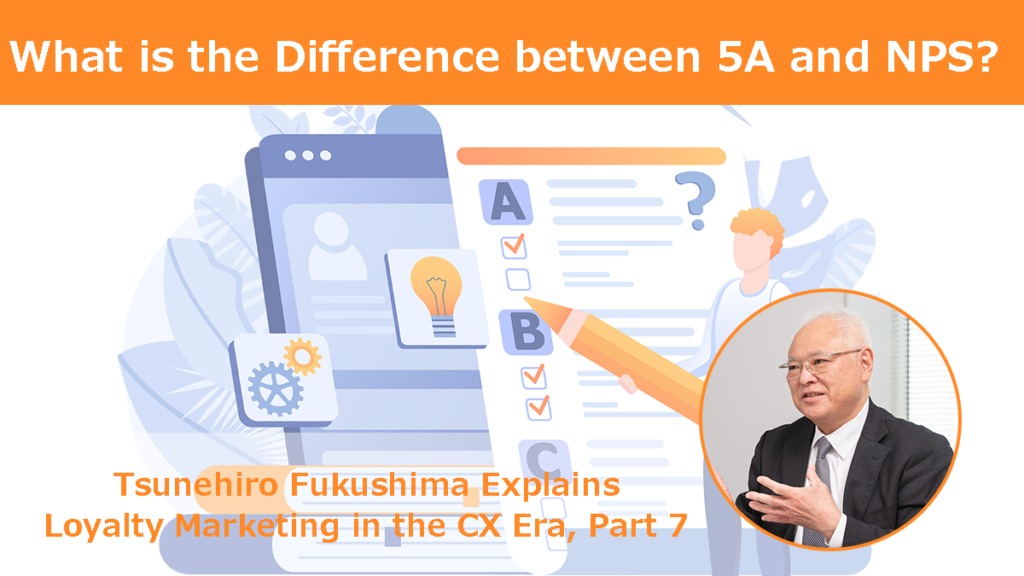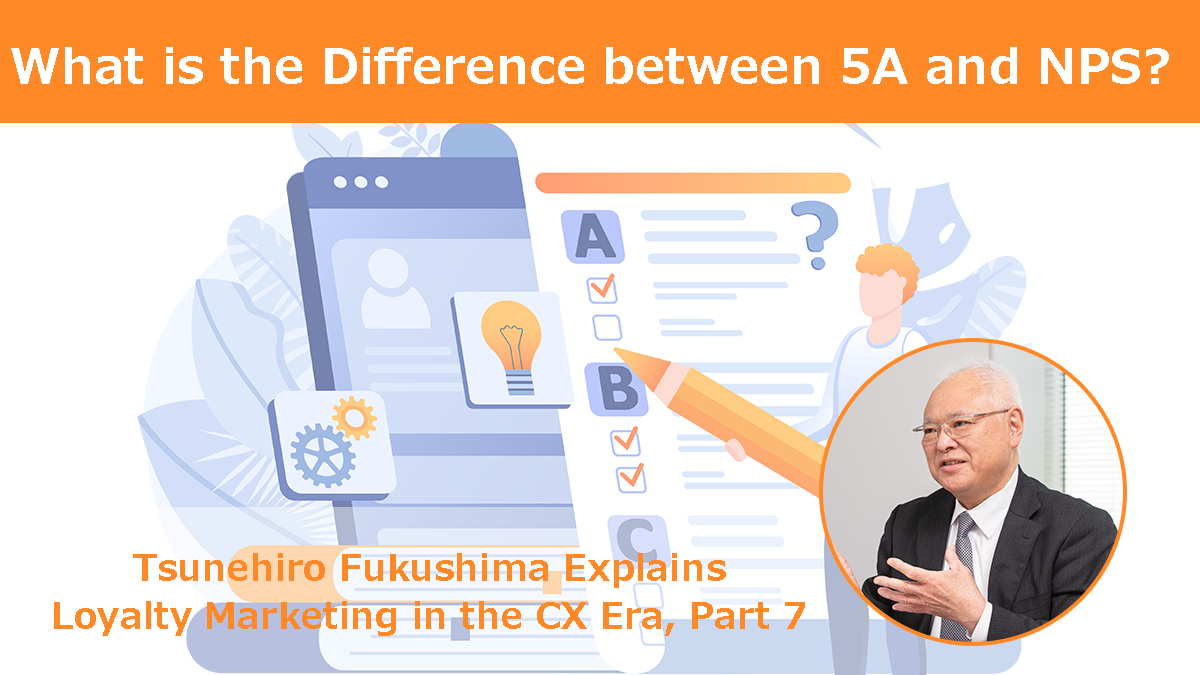NPS is widely known in Japan as an indicator to measure product and brand loyalty. I am sure that some of you are using NPS. However, there are a variety of indicators that measure loyalty. The 5As described on this site are one such example. So how do Kotler’s 5As differ from Bain’s NPS? In this article, we will explain the difference between the two and consider when each indicator is appropriate.

Contents
Loyalty measurement for multiple segments with different needs is 5A
Both the 5As proposed by Kotler and the NPS proposed by Bain are the same in that they are both indicators that measure loyalty. However, they are very different in several respects. Naturally, I would recommend 5A to everyone. Iwan Setiawan, the co-author of Kotler’s Marketing 3.0, 4.0, and 5.0, once spoke on this subject in one of our lectures. That is also Kotler’s idea. The talk is as follows.
He said, “In the United States, 30% of people would recommend a world-famous hamburger chain to others (recommenders) and 30% would not (non-recommenders). Does this mean that the chain has zero loyalty? No, it does not. In other words, in a market where there are multiple segments with different needs, it is inappropriate to measure loyalty by subtracting the non-recommenders from the recommenders.”
I agree. In other words, if the market is mass and consists of similar needs, then the NPS measure may be the way to go. We can simply add up the number of people who praise (positive) and those who say bad things (negative). However, these days, customer needs are often very complex and diverse, and we don’t think it is necessary to include the opinion that “I don’t want to recommend” in the index in such cases. Especially in Japan, non-promoters will not have much influence because they do not impose their opinions on others very often. They just don’t use it silently.
When NPS is valid and when it is not suitable
For example, NPS is an appropriate way to measure employee satisfaction in your company. Since companies want all employees to be satisfied with the same recommendations, they should rather not segment them. There is no such thing that they want them to have loyalty to the company domestically, but don’t want to have it globally.
In the aforementioned example of hamburger chains, it may be difficult to imagine Japan as a society without much hierarchy, but overseas, inexpensive hamburger chains are considered only food for the poor. It means that it is not a restaurant that people above a specific class go to. That is also the case in Korea, where people are educated from childhood that it is a store they are not allowed to enter. In contrast, Starbucks is considered to be a place where people of a higher class tend to go, but in Japan, there are probably not many people with this kind of awareness.
In other countries, hierarchies are clearly defined, and the stores used by different hierarchies are different in the first place. In such a society, NPS cannot adequately measure loyalty. If there is a segment, the recommended and non-recommended should not be subtracted. In the U.S., the main segment of McDonald’s users is said to be low-income senior citizens. In this case, we should measure loyalty by focusing on low-income seniors, not the market as a whole. If they are willing to use the service, it should be valued as loyalty.
People not associated with the product or brand “don’t want to recommend it.”
When measuring loyalty to a product or brand, it is crucial to understand that it is natural that people who are not associated with that product or brand would not want to recommend it. If you ask men about sanitary products, for example, they will not want to endorse them. But that does not mean they have a negative opinion of the product. They simply do not want to recommend it because it has nothing to do with them. So, for example, if you did an NPS survey of 100 men and 100 women on whether they wanted to recommend a particular menstrual product, and there were 50 men, they would say they did not want to recommend it, which would be a major negative factor. It would be clear that this is wrong as an original loyalty.
NPS and 5A do not match for the same loyalty
We are conducting an interesting survey: we are continuously measuring the NPS and 5A to see if they match. The results of this survey do not match at all.
NPS is for “would like to recommend.” The 5As are those who “have recommended.” Those who “want to recommend and have recommended” are true fans, loyal users, and recommenders. While 5A asks about the “action” of “making a recommendation,” NPS asks about the “consciousness” of “wanting to recommend” or not.
There are also those who “don’t want to recommend it and haven’t recommended it”. There are those who have not recommended it but would like to do so in the future and those who have recommended it but no longer wish to do so. There are a variety of people who have been using the product for many years and have more and more dislikes about it, and others who would like to recommend it someday. We need to look at the characteristics of each and interpret them according to the market. Our company conducts this kind of analysis on a research basis.
These differences are significant, but the critical difference as to why 5A is not as popular as NPS is that the original 5A indicator is “private”. The NPS is open innovation. We want to make the indicators available to the public so that more and more people can use them and do more and more research. That is what we really want to do with the 5As.
I hope you now understand the difference between NPS and 5A. 5A is not yet as popular as NPS, but in today’s marketing environment, where you need to make sure people have recommended you, which is better suited? Please consider measuring loyalty in the 5As.
* Net Promoter®, NPS®, NPS Prism®, Net Promoter System®, and the NPS-related emoticons are registered trademarks of Bain & Company, Inc., NICE Systems, Inc., and Fred Reichheld. Net Promoter Score℠ is a service mark of Bain & Company, Inc., NICE Systems, Inc., and Fred Reichheld. Coro® is a service mark of Bain & Company, Inc.
Tsunehiro Fukushima will direct your marketing efforts
At transcosmos, we offer marketing strategy proposals in line with the 5A concept advocated by Philip Kotler. For actual proposals, Tsunehiro Fukushima, the commentator of this article, supports loyalty marketing optimized for the digital age. First of all, please tell us your company’s concerns.
Tsunehiro Fukushima
Corporate Executive Officer, transcosmos inc.
Director, Japan Marketing Association
After completing graduate studies at the Tokyo Institute of Technology, he joined Ajinomoto Co., Inc. He then worked for GE Capital, Mitsubishi Corporation, Gurunavi, Inc., and Medical Data Vision Co., Ltd., where he served as head of big data business and marketing. His areas of expertise include new business and new product development, brand theory, medical business, and loyalty marketing. At transcosmos, he is in charge of marketing-related business development and is the exclusive provider in Japan of the 5A diagnosis introduced in the book “Kotler’s Marketing 4.0”.

